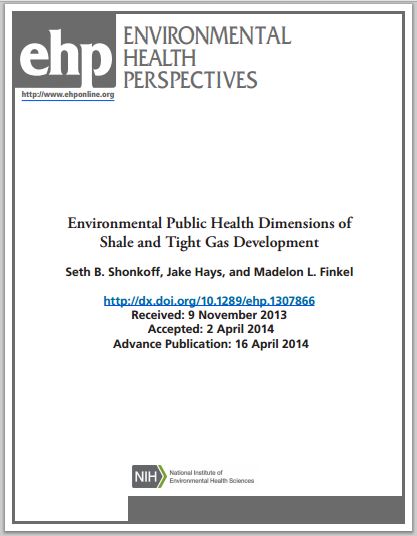Third Report in Three Days Shows Scale Of Fracking Perils, ‘We can conclude that this process has not been shown to be safe’ by Jacob Chamberlain, April 19, 2014, Mint Press News
The fracking industry is having a bad week. In the third asssessment in as many days focused on the pollution created by the booming industry, a group of researchers said Wednesday that the controversial oil and gas drilling practice known as fracking likely produces public health risks and “elevated levels of toxic compounds in the environment” in nearly all stages of the process.
The latest research, conducted by the Physicians Scientists & Engineers for Healthy Energy, compiled “the first systematic literature review” of peer-reviewed studies on the effects of fracking on public health and found the majority of research points to dangerous risks to public health, with many opportunities for toxic exposure.
“It’s clear that the closer you are [to a fracking site], the more elevated your risk,” said lead author Seth Shonkoff, from the University of California-Berkeley. “We can conclude that this process has not been shown to be safe.”
According to the “near exhaustive review” of fracking research, environmental pollution is found “in a number of places and through multiple processes in the lifecycle of shale gas development,” the report states. “These sources include the shale gas production and processing activities (i.e., drilling, hydraulic fracturing, hydrocarbon processing and production, wastewater disposal phases of development); the transmission and distribution of the gas to market (i.e., in transmission lines and distribution pipes); and the transportation of water, sand, chemicals, and wastewater before, during, and after hydraulic fracturing.”
Citing the recent research, the report continues:
Shale gas development uses organic and inorganic chemicals known to be health damaging in fracturing fluids (Aminto and Olson 2012; US HOR 2011). These fluids can move through the environment and come into contact with humans in a number of ways, including surface leaks, spills, releases from holding tanks, poor well construction, leaks and accidents during transportation of fluids, flowback and produced water to and from the well pad, and in the form of run-off during blowouts, storms, and flooding events (Rozell and Reaven 2012). Further, the mixing of these compounds under conditions of high pressure, and often, high heat, may synergistically create additional, potentially toxic compounds (Kortenkamp et al. 2007; Teuschler and Hertzberg 1995; Wilkinson 2000). Compounds found in these mixtures may pose risks to the environment and to public health through numerous environmental pathways, including water, air, and soil (Leenheer et al. 1982). […]
At certain concentrations or doses, more than 75% of the chemicals identified are known to negatively impact the skin, eyes, and other sensory organs, the respiratory system, the gastrointestinal system, and the liver; 52% have the potential to negatively affect the nervous system; and 37% of the chemicals are candidate endocrine disrupting chemicals.
The group also warns that while numerous studies have proven the alarming and destructive nature of fracking, there is still not nearly enough research on the issue, particularly on the long-term effects of fracking on public health, such as future cancer rates. “Most importantly,” say the authors, “there is a need for more epidemiological studies to assess associations between risk factors, such as air and water pollution and health outcomes among populations living in close proximity to shale gas operations.” [Emphasis added]
Environmental Public Health Dimensions of Shale and Tight Gas Development by Seth B. Shonkoff, Jake Hays, and Madelon L. Finkel, April 16, 2014, Environ Health Perspect; DOI:10.1289/ehp.1307866
Accessible PDF Version (788 KB)
Abstract
Background: The United States has experienced a boom in natural gas production due to recent technological innovations that have enabled this resource to be produced from shale formations.
Objectives: This review discusses the body of evidence that focuses on exposure pathways to evaluate the potential environmental public health impacts of shale gas development. It highlights what is currently known and identifies data gaps and research limitations by addressing matters of toxicity, exposure pathways, air quality, and water quality.
Discussion: There is evidence of potential environmental public health risks associated with shale gas development. A number of studies suggest that shale gas development contributes to levels of ambient air concentrations known to be associated with increased risk of morbidity and mortality. Similarly, an increasing body of studies suggest water contamination risks exist through a variety of environmental pathways, most notably during wastewater transport and disposal and via poor zonal isolation of gases and fluids due to structural integrity impairment of cement in gas wells.
Conclusion: Despite a growing body of evidence, a number of data gaps persist. Most importantly, there is a need for more epidemiological studies to assess associations between risk factors, such as air and water pollution and health outcomes among populations living in close proximity to shale gas operations.
 PSE Study Citation Base: 292 references
PSE Study Citation Base: 292 references
[Refer also to:
“By any responsible account,” [Pennsylvanian Supreme Court] Chief Justice Castille wrote, “the exploitation of the Marcellus Shale Formation will produce a detrimental effect on the environment, on the people, their children, and the future generations, and potentially on the public purse, perhaps rivaling the environmental effects of coal extraction.”
